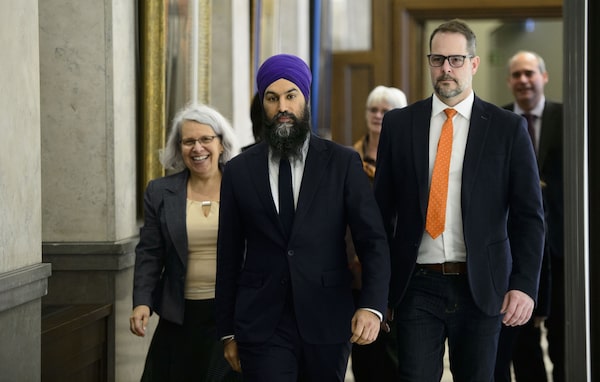
NDP Leader Jagmeet Singh is joined by fellow party members as he arrives to hold a press conference on Parliament Hill in Ottawa on March 20, 2019.Sean Kilpatrick/The Canadian Press
Jagmeet Singh had cause to be mildly relieved when he saw the federal budget on Tuesday, if also a tiny bit offended.
Heading in, Mr. Singh’s New Democrats fretted about Justin Trudeau’s government using its final fiscal plan before October’s expected federal election to neutralize issues the NDP wants to spend the campaign talking about.
Doing so would have fit a familiar strategy for the Liberals. As in 2015, when Mr. Trudeau made the surprise announcement that he would run deficits to allow more spending, they often use the precampaign period or the campaign’s early stages to try to box out the NDP, rallying the centre-left behind themselves for a head-to-head battle with the Conservatives in the campaign’s final weeks.
The plan delivered this week by Finance Minister Bill Morneau didn’t abandon that strategy, exactly. For one thing, the Liberals are still choosing to run deficits. And their budget is loaded with modest measures – subsidies for clean technology, help with student loans, new spending on culture, a cap on stock-option deductions used by high-income earners with large companies – that could play well with Liberal-NDP swing voters. (The same goes for increased spending on Indigenous services, although it might be cynical to ascribe that primarily to election positioning.)
But if the Liberals were really committed to pulling the rug out from under Mr. Singh, they would not have left him as much room to use big, ambitious promises to define himself and contrast his values with theirs.
At the top of the list is pharmacare. Despite speculation about the Liberals using the budget to promise a national program of their own, their imminent commitment proved to be $35-million toward a new agency, tasked with listing drugs that should be available to all Canadians regardless of ability to pay, and with leading drug-price negotiations. That may be a precursor to a national program, and they also promised up to $1-billion for drugs to treat rare diseases, starting in three years. But it leaves lots of room for the NDP to argue that the Liberals aren’t moving urgently to help the millions of uninsured Canadians.
On housing, the subject to which Mr. Singh recently devoted his first question in Parliament, the budget did more. But the measures, including a $1.25-billion mortgage-sharing program and an increase to the amount first-time buyers can withdraw from RRSPs, are mostly geared toward home ownership. Other than expanding a loan program for developers of new housing, the Liberals didn’t do much to address rental affordability, again ceding ground to Mr. Singh in speaking to the needs of lower-income voters.
And other potential big-spending answers for Canadians struggling to make ends meet, of the sort the NDP may run on, were left more or less untouched by this budget – child care being the most obvious example.
The Liberals were constrained by deficits set by their previous budgets, which contained many spending commitments spread over many years. Unless they were willing to either raise taxes or go significantly deeper into the red, there was only so much they could do.
But the way their pre-election plan distributes small amounts of money across a vast array of policy areas suggests that the Liberals prioritized showing something to every voting demographic available to them, rather than taking bigger action on a few files that could ward off NDP challenges to their values.
It’s not a great mystery why that is.
The NDP’s polling numbers are grim, its fundraising returns worse, and many of its MPs aren’t seeking re-election. A year and a half into his leadership, Mr. Singh has shown few signs of being up to the daunting task of persuading voters who dislike the Conservatives that they should risk vote-splitting by casting their votes with the NDP.
But there is one caveat: Nobody has actually seen Mr. Singh lead a party into a campaign yet. And low expectations can be a politician’s best friend.
Improbable though it may be, based on his tentative performance to date, it’s not inconceivable he could prove compelling enough on the hustings − or in leaders’ debates − to get some traction. If that happened, it could be too late for the Liberals to head off the NDP, the way they might have this week.
In the meanwhile, Mr. Singh at least has lots of space he can carve out for himself. And he has extra incentive to prove he’s been underestimated, if he somehow didn’t have enough already.
 Adam Radwanski
Adam Radwanski